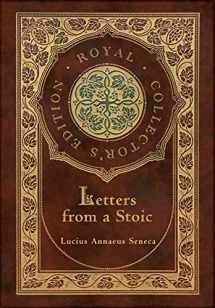
Letters from a Stoic (Complete) (Royal Collector's Edition) (Case Laminate Hardcover with Jacket)
Book details
Summary
Description
Product Description
Letters from a Stoic, include the complete surviving collection of 124 letters that Seneca the Younger wrote at the end of his life. They were written during his retirement, after he had worked for the Emperor Nero for more than ten years. They are addressed to Lucilius, the then procurator of Sicily, who is known only through Seneca's writings. The letters focus on many traditional themes of Stoic philosophy such as the contempt of death, the stout-heartedness of the sage, and virtue as the supreme good.
Regardless of how Seneca and Lucilius actually corresponded, it is clear that Seneca crafted the letters with a broad readership in mind. The letters often begin with an observation on daily life, and then proceed to an issue or principle abstracted from that observation. The result is like a diary, or handbook of philosophical meditations. Seneca's letters are focused on the inner-life, and the joy that comes from wisdom. He emphasizes the Stoic theme that virtue is the only true good and vice the only true evil.
This case laminate collector's edition includes a Victorian inspired dust-jacket.
About the Author
Seneca the Younger (c. 4 BC - AD 65), fully Lucius Annaeus Seneca and also known simply as Seneca, was a Roman Stoic philosopher, statesman, dramatist, and-in one work-satirist of the Silver Age of Latin literature. Seneca was born in Corduba in Hispania, and raised in Rome, where he was trained in rhetoric and philosophy. His father was Seneca the Elder, his elder brother was Lucius Junius Gallio Annaeanus, and his nephew was the poet Lucan. In AD 41, Seneca was exiled to the island of Corsica by the emperor Claudius, but was allowed to return in 49 to become a tutor to Nero. When Nero became emperor in 54, Seneca became his advisor and, together with the praetorian prefect Sextus Afranius Burrus, provided competent government for the first five years of Nero's reign. Seneca's influence over Nero declined with time, and in 65 Seneca was forced to take his own life for alleged complicity in the Pisonian conspiracy to assassinate Nero, in which he was likely to have been innocent. His stoic and calm suicide has become the subject of numerous paintings. As a writer, Seneca is known for his philosophical works, and for his plays, which are all tragedies. His prose works include a dozen essays and one hundred twenty-four letters dealing with moral issues. These writings constitute one of the most important bodies of primary material for ancient Stoicism. As a tragedian, he is best known for plays such as his Medea, Thyestes, and Phaedra. Seneca's influence on later generations is immense-during the Renaissance he was a sage admired and venerated as an oracle of moral, even of Christian edification; a master of literary style and a model for dramatic art.


We would LOVE it if you could help us and other readers by reviewing the book
Book review



